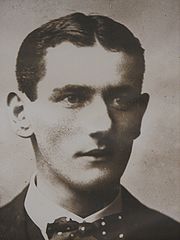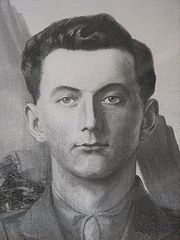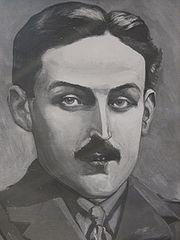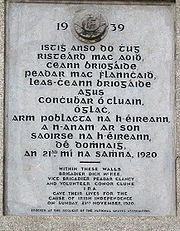
Conor Clune
Encyclopedia

Dick McKee
Richard “Dick” McKee was a prominent member of the Irish Republican Army . He was also friend to some senior members in the republican movement, including Éamon de Valera, Austin Stack and Michael Collins...
and Peadar Clancy
Peadar Clancy
Peadar Clancy was a member of the Irish Republican Army who served in the Four Courts garrison during the 1916 Easter Rising and was second-in-command of the Dublin Brigade, IRA during the War of Independence...
killed in controversial circumstances in Dublin Castle
Dublin Castle
Dublin Castle off Dame Street, Dublin, Ireland, was until 1922 the fortified seat of British rule in Ireland, and is now a major Irish government complex. Most of it dates from the 18th century, though a castle has stood on the site since the days of King John, the first Lord of Ireland...
on Bloody Sunday
Bloody Sunday (1920)
Bloody Sunday was a day of violence in Dublin on 21 November 1920, during the Irish War of Independence. In total, 31 people were killed – fourteen British, fourteen Irish civilians and three republican prisoners....
, 1920, a day that also saw the killing of a network of British spies by the "Squad" unit of the Irish Republican Army
Irish Republican Army
The Irish Republican Army was an Irish republican revolutionary military organisation. It was descended from the Irish Volunteers, an organisation established on 25 November 1913 that staged the Easter Rising in April 1916...
and the killing of 14 people in Croke Park
Croke Park
Croke Park in Dublin is the principal stadium and headquarters of the Gaelic Athletic Association , Ireland's biggest sporting organisation...
by British forces
British Army
The British Army is the land warfare branch of Her Majesty's Armed Forces in the United Kingdom. It came into being with the unification of the Kingdom of England and Scotland into the Kingdom of Great Britain in 1707. The new British Army incorporated Regiments that had already existed in England...
.
Early life
Conor Clune was born in the village of Quin, County ClareQuin, County Clare
Quin is a village in southeast County Clare in Ireland. The village's main attraction, Quin Abbey, is open to the public, and although mostly ruined, much of the structure remains. The abbey was built on the foundations of an earlier Norman castle, and the foundations of its corner towers can...
, the son of John and Bridget Clune (née Walsh) of Kilkishen. Clune was one of a family of seven boys and three girls. His uncle was Patrick Clune
Patrick Clune
His Grace The Most Rev. Dr. Patrick Joseph Clune, C.Ss.R., D.D. was the first Catholic Lord Archbishop of Perth, a position he held from 1913 - 1935. He was also the Lord Bishop of Perth from 1910 to 1913....
, Bishop of Perth, Western Australia
Perth, Western Australia
Perth is the capital and largest city of the Australian state of Western Australia and the fourth most populous city in Australia. The Perth metropolitan area has an estimated population of almost 1,700,000....
, who became the first Archbishop of Perth in 1913. He was educated at the local National School and St. Flannan’s College, Ennis. A Gaelic League enthusiast, he also spent some time at Ring Irish College, Colaiste na Rinne, Co. Waterford. From a young age he was active in Gaelic League circles, and spoke Irish on every occasion possible.
Involvement in Nationalist Organisations
Clune was at one time a member of the National VolunteersNational Volunteers
The National Volunteers was the name taken by the majority of the Irish Volunteers that sided with Irish Parliamentary Party leader John Redmond after the movement split over the question of the Volunteers' role in World War I.-Origins:...
, the military organisation led by John Redmond
John Redmond
John Edward Redmond was an Irish nationalist politician, barrister, MP in the House of Commons of the United Kingdom of Great Britain and Ireland and leader of the Irish Parliamentary Party from 1900 to 1918...
that resulted from the 1914 split in the Irish Volunteers
Irish Volunteers
The Irish Volunteers was a military organisation established in 1913 by Irish nationalists. It was ostensibly formed in response to the formation of the Ulster Volunteers in 1912, and its declared primary aim was "to secure and maintain the rights and liberties common to the whole people of Ireland"...
. He does not appear to have been a member of the Irish Volunteers, although the commemorative plaque in Dublin Castle refers to him as "Volunteer Conor Clune" (see picture). However, he was devoted to the Irish Language
Irish language
Irish , also known as Irish Gaelic, is a Goidelic language of the Indo-European language family, originating in Ireland and historically spoken by the Irish people. Irish is now spoken as a first language by a minority of Irish people, as well as being a second language of a larger proportion of...
and was involved with the Gaelic League.
Edward MacLysaght
Following a period during which he worked in Dublin he applied for and was appointed Manager at the seed and plant nursery owned by Edward MacLysaghtEdward MacLysaght
Edward MacLysaght was one of the foremost genealogists of twentieth century Ireland. His numerous books on Irish surnames built upon the work of Patrick Woulfe's Irish Names and Surnames and made him well known to all those researching their family past.-Early life:Edward was born in Flax Bourton...
at Raheen, Tuamgraney, about ten miles from Quin. It was with MacLysaght that he travelled to Dublin on the morning of Saturday, 20 November 1920, bringing with him the books of the Raheen Co-op for its annual audit.
Vaughan’s Hotel

Piaras Béaslaí
Piaras Béaslaí was a member of the Irish Republican Brotherhood, a member of Dáil Éireann and also an Irish author, playwright, biographer and translator....
, a member of Dáil Éireann
Dáil Éireann
Dáil Éireann is the lower house, but principal chamber, of the Oireachtas , which also includes the President of Ireland and Seanad Éireann . It is directly elected at least once in every five years under the system of proportional representation by means of the single transferable vote...
, Director of Publicity and then Editor of An t-Óglach and another Gaelic League enthusiast that evening. They parted company, after arranging to meet on the following day. Also on Saturday evening, Peadar Clancy
Peadar Clancy
Peadar Clancy was a member of the Irish Republican Army who served in the Four Courts garrison during the 1916 Easter Rising and was second-in-command of the Dublin Brigade, IRA during the War of Independence...
, along with members of the GHQ staff of the Irish Republican Army
Irish Republican Army
The Irish Republican Army was an Irish republican revolutionary military organisation. It was descended from the Irish Volunteers, an organisation established on 25 November 1913 that staged the Easter Rising in April 1916...
, met at 35 Lower Gardiner Street
Gardiner Street
Gardiner Street is in Dublin, Ireland and stretches from the River Liffey at its southern end via Mountjoy Square to Dorset Street at its northern end...
, Dublin.
The meeting was called to discuss the final arrangements for what would be the route of the British secret service, with the elimination of the Cairo Gang
Cairo Gang
The Cairo Gang was a group of British Intelligence agents who were sent to Dublin during the Anglo-Irish War to conduct intelligence operations against prominent members of the Irish Republican Army...
the following morning. Having concluded their business, the meeting dispersed, Michael Collins
Michael Collins (Irish leader)
Michael "Mick" Collins was an Irish revolutionary leader, Minister for Finance and Teachta Dála for Cork South in the First Dáil of 1919, Director of Intelligence for the IRA, and member of the Irish delegation during the Anglo-Irish Treaty negotiations. Subsequently, he was both Chairman of the...
, Clancy, McKee and some of the others went to Vaughan’s Hotel Parnell Square,then the rendezvous for many of the leaders of the IRA.
It was at this time that Clune, accompanied by Sean O’Connell, went to Vaughan’s. Beaslaí was upstairs with Brigadier Dick McKee
Dick McKee
Richard “Dick” McKee was a prominent member of the Irish Republican Army . He was also friend to some senior members in the republican movement, including Éamon de Valera, Austin Stack and Michael Collins...
, Michael Collins, Peadar Clancy
Peadar Clancy
Peadar Clancy was a member of the Irish Republican Army who served in the Four Courts garrison during the 1916 Easter Rising and was second-in-command of the Dublin Brigade, IRA during the War of Independence...
when word was brought to Beaslaí that Conor Clune from Clare was there to meet him.
While in the hotel, the porter, Christy Harte, became suspicious of one of the guests, a Mr Edwards. Edwards had made a late-night telephone call, and then left the hotel. Harte informed the Volunteers, who then quickly left the building. Beaslaí, who was familiar with the Hotel’s surroundings escaped with the other senior Volunteers including Michael Collins.
Clune was arrested in the raid which soon followed by British Auxiliaries. Clune was the only one arrested at Vaughan’s that night as he was not registered as a guest. This, according to Seán Kavanagh a member of the "Squad", would ultimately cost him his life. Clancy and McKee would also be arrested in the early hours of the morning in another part of the city, though the Cairo Gang
Cairo Gang
The Cairo Gang was a group of British Intelligence agents who were sent to Dublin during the Anglo-Irish War to conduct intelligence operations against prominent members of the Irish Republican Army...
assassination plan was already in motion, for the next day.
Dublin Castle

Brigadier General Ormonde Winter
Ormonde Winter
Brigadier-General Sir Ormonde de l'Épée Winter KBE CB CMG DSO was a British Army officer and author who after service in World War I was responsible for intelligence operations in Ireland during the Anglo-Irish War...
head of the British Secret Service in Ireland and two Auxiliary Division
Auxiliary Division
The Auxiliary Division of the Royal Irish Constabulary , generally known as the Auxiliaries or Auxies, was a paramilitary organization within the Royal Irish Constabulary during the Irish War of Independence....
officers, Captain Hardy and Captain King, were the British personnel who interrogated Clune, Clancy, and McKee.
A Republican prisoner, V J. Young, who was in custody at the time in the Castle is certain that Clune was killed in error for Sean Fitzpatrick the man arrested with McKee and Clancy at Fitzpatrick’s home in Gloucester St. Clune and Fitzpatrick he says were of similar build and both were wearing brown suits. Young overheard two Auxiliary officers disputing the identity of one of the prisoners. One said, “That’s him” while another said” no, its him” as they looked at just Fitzpatrick and Clune.
According to T. Ryle Dwyer, the prisoners "supposedly" got hold of the hand grenades and threw them. One of the sentries testified that himself and a colleague heard a noise behind them and noticed that two of the prisoners had thrown the grenades at them. They dived for cover behind some mattresses, but the grenades did not detonate. One of the prisoners was also said to have got hold of a rifle according to one of the guards, which he levelled and fired at the guard commander as he entered the room, but missed. The prisoner then turned the rifle and fired another shot at another guard. The guard said he then fired at the prisoner, and the prisoner dropped, and that the guard commander also fired at the prisoner.
The guard commander said, on hearing a noise, entered the room, and "the prisoner McKee fired at me", and that McKee then turned and fired at the sentry. The guard commander also claimed to have dropped McKee. He then said he saw Clancy with a shovel, and that Clancy was attempting to strike another guard. One of the guards (who had dived behind the mattresses) then fired at Clancy and he fell.

According to Sean O'Mahony, they were tortured in the guardroom in order to extort from them the names of the Volunteers who had earlier that morning shot the fourteen members of the Cairo Gang
Cairo Gang
The Cairo Gang was a group of British Intelligence agents who were sent to Dublin during the Anglo-Irish War to conduct intelligence operations against prominent members of the Irish Republican Army...
. Refusing to talk, they were "subsequently murdered" on the evening of 21 November 1920.
The condition of their bodies when returned by the British authorities to their families supports this assertion. There were extensive signs of discolouring, which seemed to indicate extensive bruising. The army doctor claimed that large staining could occur, and this would depend on the way the bodies had been lying. He also said that Clancy had been hit with up to five bullets, which made eight wounds; Dick McKee had three wounds caused by two bullets. He said McKee had no bayonet wounds, but there was a bullet lodged underneath his skin on the right of his chest. Clune, he said, had nine wounds caused by seven bullets. T. Ryle Dwyer also states that David Neligan
David Neligan
David Neligan , known by his soubriquet "The Spy in the Castle", was an important figure involved in the Irish War of Independence 1919-1921, and subsequently became Director of Intelligence for the Irish Army after the Irish Civil War -Early life:David Neligan was born at Templeglantine, Limerick,...
was adamant that they had not been bayoneted.
His employer Edward McLysaght took charge of the body when the authorities released it. He had the body medically examined. The examination proved that Clune was shot 13 times in the chest. Clune’s body was brought home to Co. Clare for burial. His coffin was draped with the tricolour but when a British Officer objected to it, Canon Slattery the presiding priest complied and removed the national flag. He is buried in Quin Abbey near his ancestors, Clune was 27 years of age.
A book titled Death in the Castle: Three murders in Dublin Castle 1920, written by Sean O'Mahony, and published by 1916–1921 Club
1916–1921 Club
The 1916–1921 Club was founded in the 1940s. The motivation for the Club was to heal the divisions created by the Irish Civil War. Protagonists from both sides were invited to join. The Association of the Old Dublin Brigade, Óglaigh na hÉireann was also open to the surviving members of the War of...
records both the life and deaths of the three Republicans.
There is a road in Dublin, close to the Phoenix Park
Phoenix Park
Phoenix Park is an urban park in Dublin, Ireland, lying 2–4 km west of the city centre, north of the River Liffey. Its 16 km perimeter wall encloses , one of the largest walled city parks in Europe. It includes large areas of grassland and tree-lined avenues, and since the seventeenth...
called Conor Clune Road.

